|
Marching Thru Georgia
by Bob Brooke
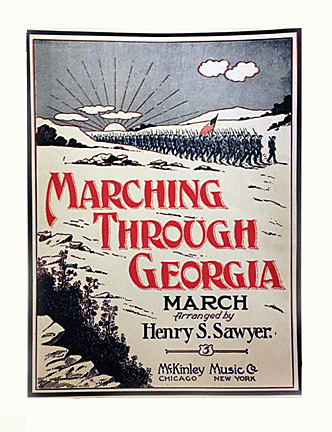 The
song “Marching Thru Georgia,” written by Henry Clay Work in 1865 at the
end of the Civil War in 1865, refers to U.S. Army major general William
Tecumseh Sherman's "March to the Sea" to capture the Confederate city of
Savannah, Georgia, in late 1864. It became widely popular among veteran
Union soldiers and appeared in thousands of copies of sheet music. The
song “Marching Thru Georgia,” written by Henry Clay Work in 1865 at the
end of the Civil War in 1865, refers to U.S. Army major general William
Tecumseh Sherman's "March to the Sea" to capture the Confederate city of
Savannah, Georgia, in late 1864. It became widely popular among veteran
Union soldiers and appeared in thousands of copies of sheet music.
Back before marvels such as the phonograph and roller organ, families
entertained themselves in the evenings after dinner by gathering around
the piano for a sing-a-long. This necessitated the publishing of sheet
music for hundreds of songs.
Originally people collected sheet music primarily for the music score.
Depending on rarity, with a wide range in value, sheet music is easy to
collect, having been mass produced for much of the 19th century, but it
didn’t reach its peak production until the decade of 1900-1910, when
titles such as “Let Me Call You Sweetheart” and “Down by the Old Mill
Stream” sold up to six million copies.
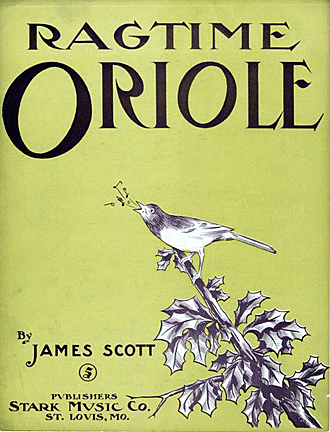 Most
collectors focus on specific areas of sheet music. Titles can be broken
down into varying categories, including Civil War and military, ragtime,
jazz, Broadway and film scores, and sports songs like “Take Me Out to
the Ballgame.” Some collectors focus on notable composers like Irving
Berlin, to famous film personalities such as Eddie Cantor, The Marx
Brothers and Bing Crosby. Most
collectors focus on specific areas of sheet music. Titles can be broken
down into varying categories, including Civil War and military, ragtime,
jazz, Broadway and film scores, and sports songs like “Take Me Out to
the Ballgame.” Some collectors focus on notable composers like Irving
Berlin, to famous film personalities such as Eddie Cantor, The Marx
Brothers and Bing Crosby.
One of the primary collecting categories is famous composers like Irving
Berlin, Gershwin, Kern, Porter, because they’re worth more. Then you
have the importance of the personality. People think Bing Crosby and
Rudy Vallee or people like that are of importance. No! Important stars
on sheet music would be Mae West and other blonde bombshells like Jayne
Mansfield, Marilyn Monroe, Brigitte Bardot, comedy groups like The Marx
Brothers, the Three Stooges, Laurel and Hardy, Wheeler and Woolsey;
there aren’t as many of them. Judy Garland is collectible, always has
been and always will be.
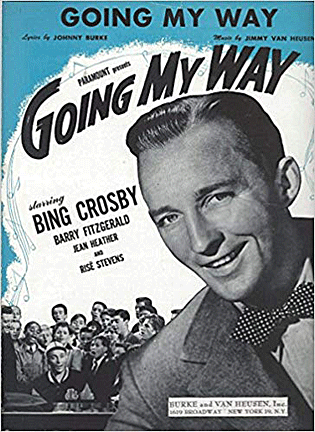 Some
people collect every piece of sheet music with songs about a famous
person such as Charles Lindbergh. Songs related to Lingbergh number in
the hundreds. These same people collect all the memorabilia related to
Lindbergh as well. Some
people collect every piece of sheet music with songs about a famous
person such as Charles Lindbergh. Songs related to Lingbergh number in
the hundreds. These same people collect all the memorabilia related to
Lindbergh as well.
Some collectors focus on tunes by a specific singer, such as Al Jolson,
Billy Holiday, and Bing Crosby. Many popular singers did their part for
the various war efforts and can be found on military sheet music. Eddie
Cantor is pictured on the cover “A Wing and a Prayer.”
Military Music
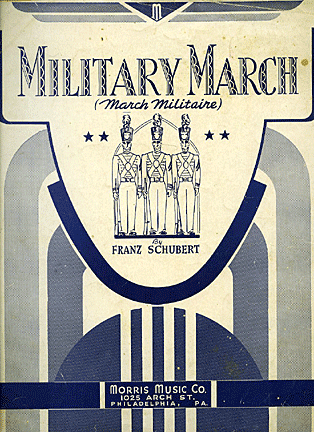 For
centuries, armies have marched to tunes played on trumpet and drum.
Music kept soldiers in step by the rhythm, and a song's repetitive
phrases helped remove focus from their aching feet and tired bones.
Politicians used these same military march tunes to motivate those on
the home front. Many of these stirring tunes appeared as sheet music,
sometimes referred to as "song sheets." Although most families no longer
gather around the piano to sing songs, sheet music tunes haven’t been
forgotten. For
centuries, armies have marched to tunes played on trumpet and drum.
Music kept soldiers in step by the rhythm, and a song's repetitive
phrases helped remove focus from their aching feet and tired bones.
Politicians used these same military march tunes to motivate those on
the home front. Many of these stirring tunes appeared as sheet music,
sometimes referred to as "song sheets." Although most families no longer
gather around the piano to sing songs, sheet music tunes haven’t been
forgotten.
Today, military sheet music provides an intriguing glimpse into American
history. Among the events captured in lyric and note were the
Revolutionary War battle of Trenton, the Civil War battle of Shiloh, the
fall of Richmond, as well as events from World War I and II. Not all the
tunes were Georgia written at the time of the event. Johnny Cash
recorded Remember the Alamo in 1963. In fact, one way of organizing a
collection of military sheet music is by the battle or era.
Sheet Music Covers
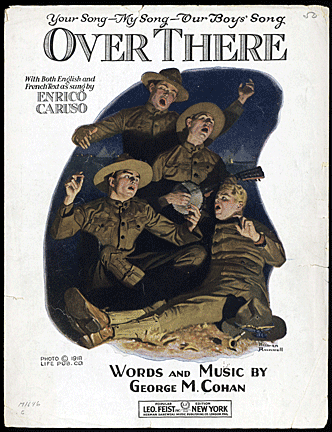 Collectors
don't need to be able to read music or play a musical instrument
appreciate sheet music. Many collectors are interested in the artwork on
the covers and focus on the artists who produced sheet music covers.
Early music sheets contain some of the finest examples of American
lithography. Military dress uniforms provided a rewarding subject for
sheet music cover art in brilliant color. The golden age of illustrated
covers lasted from 1885 to 1952. Among the artists whose cover
illustrations are collectible are Norman Rockwell, James Montgomery
Flagg, Albert W. Barbelle and Edward H. Pfeiffer. Collectors
don't need to be able to read music or play a musical instrument
appreciate sheet music. Many collectors are interested in the artwork on
the covers and focus on the artists who produced sheet music covers.
Early music sheets contain some of the finest examples of American
lithography. Military dress uniforms provided a rewarding subject for
sheet music cover art in brilliant color. The golden age of illustrated
covers lasted from 1885 to 1952. Among the artists whose cover
illustrations are collectible are Norman Rockwell, James Montgomery
Flagg, Albert W. Barbelle and Edward H. Pfeiffer.
Besides by era, other ways to collect sheet music are by composer, song
type, or by cover art or artist. Since song sheets might be issued in as
many as six different cover versions, depending on who was featured,
collectors are also able to collect series.
William F. “Buffalo Bill” Cody, for instance, appeared on horseback with
a rifle on the front cover of a rare 10 x 13-inch copy of sheet music.
While men have frequently been featured on the covers, especially of the
earlier military sheet music, a collector can also build a collection
around covers depicting women in uniform.
Covers with celebrities are another area where sheet music are another
crossover collectible.
Collecting Music Related Items
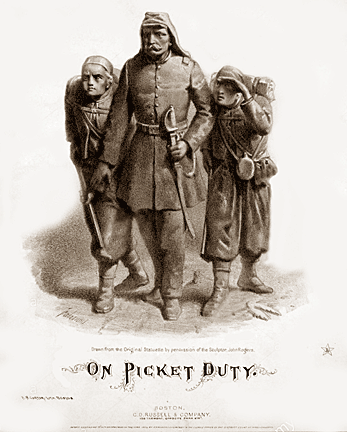 Collecting
related music in other formats and other memorabilia can complement a
sheet music collection. For example, singers recorded songs on 33 RPM
stereo and mono records and 45 RPM records by such companies as RCA
Victor. Military sheet music can also cross over into other collecting
areas. The John Rodgers sculpture group “On Picket Duty” inspired a
sheet music cover for an 1864 song, produced by F.N. Carter, a Boston
lithographer. Collecting
related music in other formats and other memorabilia can complement a
sheet music collection. For example, singers recorded songs on 33 RPM
stereo and mono records and 45 RPM records by such companies as RCA
Victor. Military sheet music can also cross over into other collecting
areas. The John Rodgers sculpture group “On Picket Duty” inspired a
sheet music cover for an 1864 song, produced by F.N. Carter, a Boston
lithographer.
What makes a piece of sheet music valuable?
The importance of the composer, the importance of the star and the
importance of the category impacts the value. The importance of it is
everything, and rarity has the greatest effect on the value, more so
than condition.
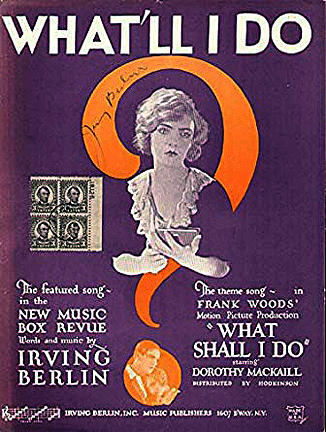 Novice
collectors need to learn the value of a sheet and buy accordingly. The
myth that specialized collections cost more just isn’t true. Also, where
sheet music is purchased can drastically affect is price. Sheet music
from the 1950s has been found for just a few dollars in a box under a
table at a yard sale or flea market while pieces from E.T. Paul
Publishing from the 1890s to 1910 can be priced from $15 to $30, or
more, at a paper and ephemera show. Novice
collectors need to learn the value of a sheet and buy accordingly. The
myth that specialized collections cost more just isn’t true. Also, where
sheet music is purchased can drastically affect is price. Sheet music
from the 1950s has been found for just a few dollars in a box under a
table at a yard sale or flea market while pieces from E.T. Paul
Publishing from the 1890s to 1910 can be priced from $15 to $30, or
more, at a paper and ephemera show.
Where to Find Old Sheet Music
Although sheet music has been around for at least 200 years, most of
what can be readily found dates from the late 19th century through the
mid-20th. While some tunes such as the Lancers Quick Step may not be
well known to today's collectors, other tunes such as When Johnny Comes
Marching Home are still sung more than 100 years after their creation.
The completed auction site of eBay can be a good resource for sheet
music. They list what has sold and for how much. Arrange the search list
by the highest price range first, what sold or was offered for the most
amount of money.
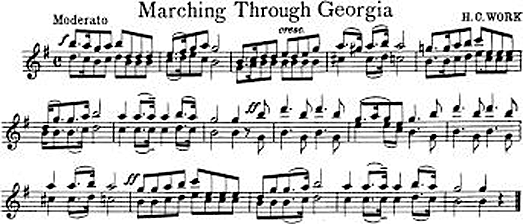
Building a Collection
Those considering collecting sheet music should collect something that
pertains to their interests. The person who plays in a brass band might
collect music by John Philip Sousa, or music about brass bands. There
are a lot of people in financial careers from banking and accounting to
the tax field. Money is a big category—from titles on the haves and the
have nots, being rich, being poor. A gardener might collect sheet music
of flower songs. The high status and high value categories are sports,
ragtime, jazz, and blues.
< Back
to Collectibles Archives
Next Article
> |
